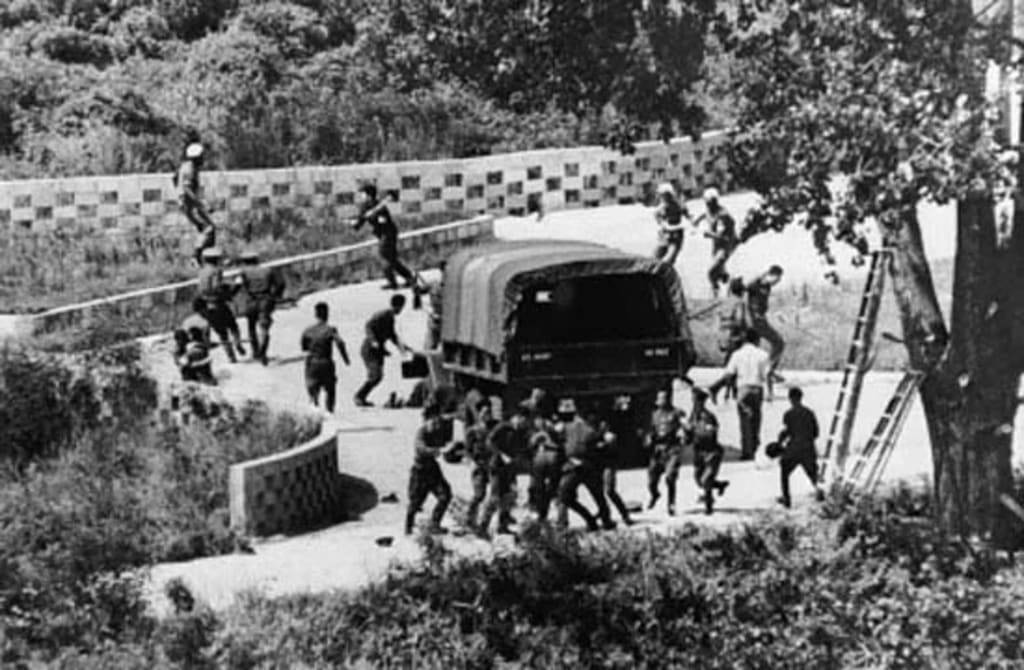War has fueled human history for millennia. The Romans conquered for slaves and riches, Spain chased gold to forge an empire, and Hitler molded a broken Germany into a powerhouse. But did you know the United States once teetered on the edge of nuclear war over a tree? Yes, a single poplar tree nearly sparked a global catastrophe. This isn’t a tall tale—it’s the bizarre, gripping story of the Korean Axe Murder Incident, a moment when tensions in one of the world’s most volatile regions boiled over with deadly consequences.
To understand this near-apocalypse, we need to step back to the Korean Peninsula’s turbulent past. Japan occupied Korea before World War I, but its defeat in 1945, at the close of World War II, left a power vacuum. The Allies hastily divided the peninsula along the 38th parallel: the Soviet Union took the north, and the U.S. claimed the south. What was meant as a temporary split hardened into permanence. The Soviets installed Kim Il-sung, a Moscow-trained communist with grand delusions, as North Korea’s leader. In 1950, he invaded the south, igniting the Korean War—a brutal three-year conflict that killed three million people. China backed the north, while the U.S. and UN forces supported the south. The war ended in 1953 with an armistice, not a peace treaty, leaving the two Koreas locked in a tense standoff.
The armistice birthed the Demilitarized Zone (DMZ), a 160-mile-long, 2.5-mile-wide buffer slicing across the peninsula. Despite its name, the DMZ is anything but peaceful—it’s the planet’s most heavily armed border. Nestled within it, just north of Seoul, lies the Joint Security Area (JSA), a small patch where North and South Korean soldiers face off daily, armed only with pistols and a lot of bravado. The JSA also houses the Bridge of No Return, a stark crossing point once used for prisoner swaps, where stepping over the line meant no turning back—straight into North Korea.
Now, enter the star of our story: a 30-meter poplar tree on the South Korean side of the JSA. For years, this tree vexed U.S. and UN forces. Towering over its neighbors, it blocked the view from a UN observation post to the bridge, creating a blind spot North Korea could exploit for a sneak attack. The North, unsurprisingly, cherished this natural shield and insisted it stay. But for the South and its allies, it was a glaring security risk at a flashpoint where every inch mattered.
By August 1976, the U.S. had had enough. On August 18, two American officers—Captain Arthur Bonifas and Lieutenant Mark Barrett—led a small team armed not with guns but with pruning tools. Joined by five Korean Service Corps workers and 11 U.S. and South Korean soldiers, their mission was simple: trim the tree to clear the sightline. They knew outright removal might provoke the North, so they opted for a compromise—just a little haircut for the poplar.
But peace didn’t last long. Minutes into the task, 15 North Korean soldiers stormed in, led by Senior Lieutenant Pak Chul, dubbed “Bulldog†by UN troops for his fiery temper. Pak demanded they stop, claiming the tree was sacred, personally planted by Kim Il-sung himself. Never mind that Kim, who fancied himself a near-deity—claiming to have single-handedly crushed Japan and boasting invincibility—probably never touched a shovel. Bonifas, unfazed, ordered his team to keep pruning and turned his back on Pak. It was a fatal miscalculation.
Furious, Pak sent for reinforcements. Moments later, a truck rolled up with 20 North Korean guards wielding crowbars and clubs. Pak issued one final warning. Bonifas ignored him again. Then Pak, in a chilling gesture, removed his watch, wrapped it in a handkerchief, pocketed it, and shouted, “Kill the bastards!†What followed was chaos. The North Koreans attacked like a swarm, overwhelming the outnumbered and unarmed UN team. Bonifas was pinned down and bludgeoned to death in seconds. Barrett fled, hiding in a ditch, but the North Koreans found him. In a horrifying scene, they took turns hacking at him with an axe until he, too, was dead. The surviving UN troops fought back with pruning tools but stood little chance. Nearby UN guards rushed Barrett to a hospital, but he didn’t make it.
North Korea’s response was predictable: deny everything. State media claimed 14 American soldiers had attacked four innocent North Koreans with axes—a bold lie even by Pyongyang’s standards. Meanwhile, the U.S. was reeling. The military jumped to DEFCON 3, a high alert status, as President Gerald Ford—who’d stumbled into the Oval Office after Nixon’s Watergate resignation—huddled with his advisors in a White House bunker. The CIA pitched wild retaliation ideas: SEAL strikes on North Korean bases, artillery barrages, even a nuclear blast off the coast as a warning. But with the Cold War at its peak and the Soviet Union backing North Korea, any move risked all-out war. Ford chose restraint—sort of.
The U.S. had wanted a trim. Now, after the murders, they demanded the tree’s total removal. Enter Operation Paul Bunyan, named after the legendary lumberjack who could fell forests with a single swing. On August 21, just three days after the attack, the U.S. unleashed a jaw-dropping show of force. Twenty-three trucks rolled into the JSA, disgorging 16 engineers with chainsaws. North Korea watched, stunned, as 60 JSA troops with pistols and axes flanked the tree. Then came 64 South Korean Special Forces commandos—black-belt taekwondo experts—armed with rifles, grenade launchers, and Claymore mines strapped to their chests, daring the North to blink.
The escalation didn’t stop there. Twenty U.S. helicopters packed with infantry buzzed overhead, joined by seven Cobra attack choppers bristling with rockets. Above them loomed 20 B-52 bombers from Guam, some possibly nuclear-armed, escorted by F-4 Phantoms and South Korean F-5 jets. Off the coast, the USS Midway, a massive aircraft carrier, stood ready with missiles and more fighters. Artillery units along the DMZ, some rumored to be nuclear-capable, locked and loaded. Oh, and 12,000 extra U.S. troops poured into South Korea, with UN forces on full alert. All this—for one tree.
In 42 minutes, the poplar was gone, reduced to a stump without a single shot fired. North Korea, with 150 troops massed across the bridge, didn’t dare intervene. They knew resistance meant annihilation. Afterward, they issued a rare statement of “regretâ€â€”as close to an apology as Pyongyang gets—perhaps realizing how close they’d come to disaster. A plaque now marks the stump, honoring Bonifas and Barrett.
The JSA was later divided, ending the days when soldiers from both sides could cross paths. The lesson? When the U.S. wants to prune a tree, don’t stand in its way. This wild chapter proves that even the smallest spark—a tree, of all things—can nearly set the world ablaze when pride and power collide.


